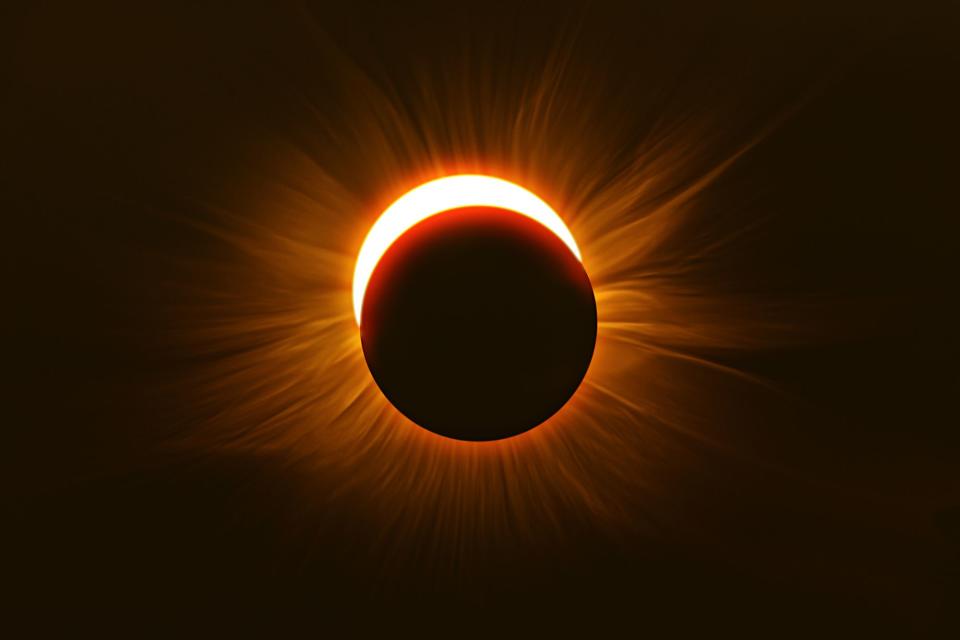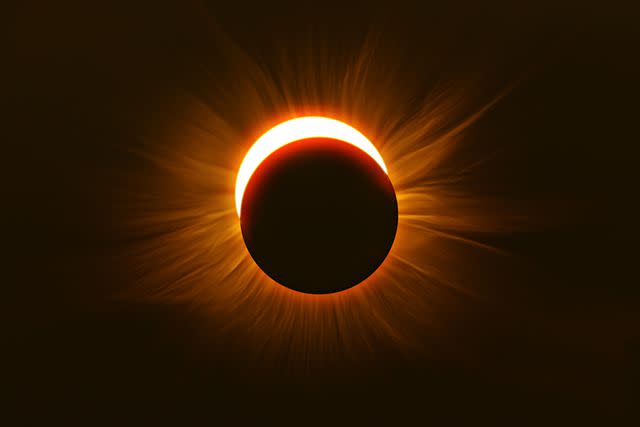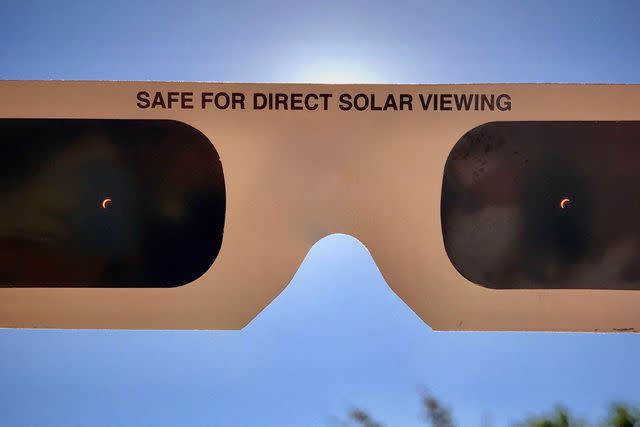This Is Where You Can See the 2024 Total Solar Eclipse Across the U.S.
Start planning now to see the next total solar eclipse.

Matt Anderson Photography/Getty Images
On April 8, 2024, a total solar eclipse will cross the United States from Texas to Maine. If you've never seen a total solar eclipse before, you're in for a treat. During this celestial phenomenon, the moon blocks out the sun's light over a narrow strip of the Earth, resulting in eerie daytime darkness for a few minutes. The event is so awe-inspiring that some people become eclipse chasers, circling the globe for each total solar eclipse. Are you ready to see the show yourself? Here's where you'll be able to see the 2024 total solar eclipse in the U.S.

Matt Anderson Photography/Getty Images
What is a total solar eclipse?
A solar eclipse occurs when the Earth, sun, and moon align in such a way that the moon's shadow falls across the surface of the Earth. From Earth, you will see the moon moving in front of the sun. A total solar eclipse occurs when the moon is in the exact right position to completely block out the sun's light. Those who are in the path of totality — the area from which the total solar eclipse is visible — will experience daytime darkness.
Related: 10 Best Places to Go Stargazing Around the World

Brian Farrell/Getty Images
How to Prepare for a Solar Eclipse
If you plan on traveling to the path of totality, make sure you book your accommodations well in advance of the eclipse. During the last total eclipse in the U.S., which occurred in 2017, more than 20 million Americans traveled to see the eclipse. And it's likely that even more will travel for the eclipse in 2024. Given that the path of totality is relatively narrow — just 115 miles wide — hotels, vacation rentals, and campsites in or near the path are likely to book up quickly.
Then there's the matter of safety. Never look into the sun with the naked eye, as you could suffer permanent optical damage. In order to safely view the eclipse, wear solar eclipse glasses, which will protect your eyes while allowing you to see the moon moving in front of the sun. Once you're in totality, you'll be able to look at the moon-obscured sun with the naked eye safely, per NASA. But once totality is over, put those glasses back on immediately.

CLAUS BECH/Getty Images
When is the 2024 solar eclipse?
The total solar eclipse will happen on April 8, 2024. The entire eclipse will last a few hours, but totality will last just a few minutes. Because the eclipse will move across the country — and will cross time zones — it'll occur at slightly different times depending on your location. If we use Universal Coordinated Time (UTC) to explain the global duration of the total solar eclipse, here's the breakdown:
Partial eclipse begins: 15:42 UTC
Total eclipse begins: 16:38 UTC
Greatest eclipse: 18:17 UTC
Total eclipse ends: 19:55 UTC
Partial eclipse ends: 20:52 UTC
Note that converting UTC into your local time zone won't necessarily sync up with the actual time of the eclipse in your location. To determine exactly when the eclipse will happen in a specific destination, consult an eclipse map. We've also shared the specific timing for destinations across the path of totality below.
Where to See the 2024 Total Solar Eclipse
Texas
The eclipse will enter Texas near Eagle Pass and exit at the border with Oklahoma and Arkansas. It will move over Fredericksburg, Austin, Waco, Fort Worth, and Dallas along the way. In Eagle Pass, totality will run from 1:27 p.m. CDT to 1:32 p.m. CDT. In Dallas, totality will run from 1:40 p.m. CDT to 1:44 p.m. CDT.
Oklahoma
The path of totality only crosses the southeastern corner of Oklahoma, most notably in the resort town of Broken Bow. Totality begins at 1:45 p.m. CDT and ends at 1:40 p.m. CDT.
Arkansas
In Arkansas, the eclipse travels from Texarkana, through Hot Springs and Little Rock, then leaves the state northeast of Jonesboro. Texarkana will enter totality at 1:46 p.m. CDT and exit it at 1:49 p.m. CDT. In Jonesboro, totality runs from 1:55 p.m. CDT to 1:58 p.m. CDT.
Missouri

larrybraunphotography.com/Getty Images
As in Oklahoma, the eclipse only traverses the southeastern corner of Missouri, moving through Poplar Bluff and Cape Girardeau. At the former, totality runs from 1:56 p.m. CDT to 2 p.m. CDT, and at the latter, 1:58 p.m. CDT to 2:02 p.m. CDT.
Illinois
The southern tip of Illinois is located along the path of totality. In Carbondale, totality starts at 1:59 p.m. CDT and ends at 2:03 p.m. EDT.
Kentucky
Only a sliver of Kentucky makes it into the path of totality. One of the few cities in the path is Paducah, where totality runs from 2 p.m. CDT to 2:02 p.m. CDT. Totality is so short here because it's on the edge of the path — the closer you are to the center of the path, the longer totality will last.
Indiana
About half of Indiana will enter totality, beginning south near Evansville, then running up through Vincennes, Bloomington, Indianapolis, and Muncie. In Evansville, totality begins at 2:02 p.m. CDT and ends at 2:05 p.m. CDT. In Muncie, the time zone changes; totality begins at 3:07 p.m. EDT and ends at 3:11 p.m. EDT.
Ohio
Most of northern Ohio will experience totality, including the cities of Dayton, Akron, and Cleveland (sorry Cincinnati and Columbus!). In Dayton, totality begins at 3:09 p.m. EDT and ends at 3:12 p.m. EDT. In Cleveland, totality runs from 3:13 p.m. EDT through 3:17 p.m. EDT.
Pennsylvania

Sean Pavone/Getty Images
Most of Pennsylvania falls outside the path of totality, but those in Erie and the surrounding area are among the lucky ones who can experience the total solar eclipse. There, totality starts at 3:16 p.m. EDT and ends at 3:20 p.m. EDT.
New York
Slice New York state diagonally from bottom left to upper right — generally speaking, everywhere above the line will be within the path of totality. That includes the cities of Buffalo, Rochester, Oswego, Syracuse, and Plattsburgh, as well as part of the Finger Lakes region, including the towns of Canandaigua, Geneva, and Seneca Falls. In Buffalo, totality begins at 3:18 p.m. EDT and runs through 3:22 p.m. EDT. In Plattsburgh, on the other side of the state, it begins at 3:25 p.m. EDT and ends at 3:29 p.m. EDT.
Vermont
Most of Vermont's popular destinations are within the path of totality, including Burlington, Stowe, and Montpelier. Because those three cities are quite close together, there's not much variation in the totality timing: 3:26 p.m. EDT to 3:29 p.m. EDT in Burlington and Stowe and 3:27 p.m. EDT to 3:29 p.m. EDT in Montpelier.
New Hampshire
Much of New Hampshire's northern reaches, where totality will be seen, are sparsely populated. The town of Colebrook makes the cut: totality runs from 3:28 p.m. EDT through 3:31 p.m. EDT.
Maine

DenisTangneyJr/Getty Images
Northern Maine is also sparsely populated, but a fair chunk of the state is in the path of totality. In Millinocket, totality starts at 3:31 p.m. EDT and ends at 3:34 p.m. EDT. The towns of Presque Isle and Caribou, as well as their neighbors, will be among the last places in the U.S. to see totality. It begins at 3:32 p.m. EDT and ends at 3:34 p.m. EDT.
For more Travel & Leisure news, make sure to sign up for our newsletter!
Read the original article on Travel & Leisure.

